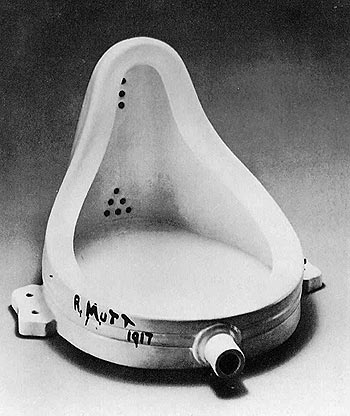Inertia as the root of evil. Is it the same as laziness? What to make of leisure present in the ideologized function of art where an aesthetic of laziness seems connected to the notion of conspicuous consumption, comparative preferences and the rest of the baggage of status and distinction that a consumer society needs to feed on.
The classic mechanism is evil arising from a condition of perceived threatening narcissism; with the resulting behavior of lashing out to destroy whoever and whatever challenges those necessary self defined images of perfection. Once established, the attitude of inertia seems to follow its own momentum, even in the face of conflicting signals and red flags; like a death wish or obsessive surrealistic exploration into the lower realms of consciousness. To change an attitude requires a considerable amount of work and suffering. It is only from wallowing in the quicksand of self inflicted confusion that can permit a less dysfunctional vision. Unless the quicksand is too deep….

---Frank Stella La scienza della pigrizia (The Science of Laziness) 1984, oil, enamel paint and alkyd paint on canvas, etched magnesium, aluminum and fiberglass, National Gallery of Art Washington DC---
…And so in February, when BBC Radio broadcast a program called The Art of Laziness, Mr. Zizek appeared on it as a uniquely qualified expert. He criticized programs that teach relaxation techniques. “If you look closely at their leaflets,” he said, “they tell you first that we are hyperactive and should learn to withdraw. But next, the second paragraph, they always say: ‘This way you will relax and be even more productive.’”
Alluding to the surrealist thinker Georges Bataille, Mr. Zizek denounced “the hidden economy of ‘I am lazy a little bit so that I will work better.’” Instead, he offered the example of residents of Montenegro, an earthquake-prone area of the former Yugoslavia. The local ethnic stereotype is that inhabitants of the region are utterly shiftless….

---Such was the story of Marcel Duchamp, the “anti-art” French artist who adopted nihilism and laziness as philosophy and bonked his friends’ wives. Duchamp was friends with Dadaists Tristan Tzara, Max Ernest, Man Ray, Jean Arp and Francis Picabia during Dada’s early years in Zurich, Paris and New York, just before and after World War I.--- Read More:http://www.africancolours.com/african-art-features/695/international/to_be_tingatinga_or_lilanga_that%E2%80%99s_the_dada.htm
…”The zero-level standard joke about laziness is how a Montenegro guy masturbates,” he said. “He digs a hole in the earth, puts his penis in, and waits for the earthquake.” The pleasure that Montenegrins take in telling the joke seems to Mr. Zizek to be the correct attitude toward both laziness and political incorrectness. “Instead of being afraid of this attitude,” he said, “you freely, in a gesture of Bataillean autonomy and sovereignty, assume” the quality attributed to you. It is not, however, an attitude that Mr. Zizek takes into the classroom. “I don’t teach,” he tells Zizek Watch. “Why should I teach? I’m not crazy.” Read More:http://www.mclemee.com/id117.htmla

---In his New York studio, the artist’s far out, laissez-faire aesthetic unfolded. One visitor mentions a shovel hanging from the ceiling. Another described the place as “a large room with a bathtub in the center which Duchamp used for his frequent ablutions, and a rope arm’s length away which allowed him to open the door without getting up.” The place was so dirty, it shocked Georgia O’Keeffe. “The dust everywhere was so thick that it was hard to believe,” she said. “I was so upset over the dusty place that the next day I wanted to go over and clean it up.” For his part, Man Ray found the squalor inspiring. Consider his “Dust Breeding” (1920)—a photograph by Man Ray of Duchamp’s piece “Large Glass” which had collected a year’s worth of dust while in the studio. Man Ray's "Dust Breeding," taken in Duchamp's New York studio in 1920. After Man Ray took the shot (with a two-hour exposure), Duchamp wiped most of the glass clean, memorializing a few patches of dust by fixing them in a diluted rubber cement mixture. “Deep down I’m enormously lazy,” said Duchamp. “I like living, breathing better than working.”--- Read More:http://encyclopediaoftheexquisite.com/?p=147
ADDENDUM:
Dr. Peter Axt, a professor of health science at Fulda University near Frankfurt, has recently written a book titled THE JOY OF LAZINESS. He concludes that everybody has a limited amount of “life energy” and the speed with which it is consumed determines their life span. If you lead a stressful life and exercise excessively, your body produces hormones which lead to high blood pressure and can damage your heart and arteries. Lazy people produce less free radicals (unstable oxygen molecules that speed up the aging process). Exercise and stress causes the body to produce the hormone cortisol which can damage cells in the brain and lead to memory loss and premature senility. Conversely, late sleepers live longer than early risers because they conserve their energy. Read More:http://bret1111.blogspot.com/2009/10/art-of-laziness.htmla

---Another display that was done earlier that year to promote Breton's Arcane 17 was only shown for a couple of hours at Brentano's when some people from the Salvation Army came into the store to tell Mr. Brentano to "go to Hell." They found the window display to be very insulting, with Duchamp's headless mannequin holding Breton's book, while piss flowed through a faucet atta
to her upper thigh (Duchamp's Lazy Hardware). Donati remembers the whole ordeal with Le Surréalisme et la Peinture to have been equally "embarrassing" to Mr. Brentano. He was so embarrassed by their comments, in fact, that he kicked Duchamp and Donati out of the store.--- Read More:http://www.toutfait.com/online_journal_details.php?postid=1095








 COMMENTS
COMMENTS



